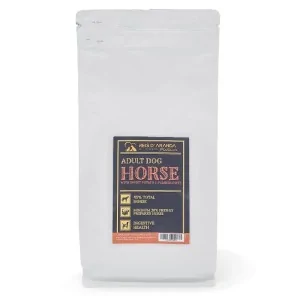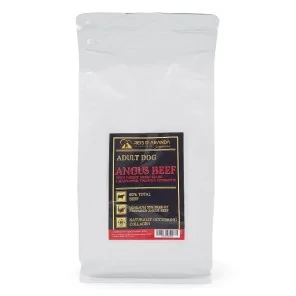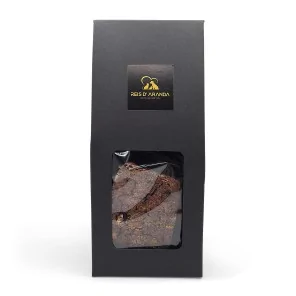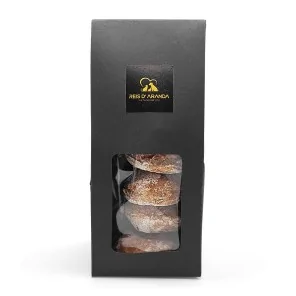The Tornjak originated from genetically homogeneous, almost extinct, indigenous shepherd dogs. These dogs have...
THE KUVASZ
INTRODUCTION
Bred for centuries as a guardian breed, the Kuvasz is protective of his home and loved ones by nature and tends to be wary of strangers. Gentle and loyal to his family, he needs a home where his owners have experience with watchdogs and can meet his specific needs.
THE ORIGIN OF THE KUVASZ
These cattle-type dogs originate from Hungary. They arrived there around the 10th century from Asia. At first, they were used as battle dogs and also for hunting wild boar, wolves and bears. Over time, their function shifted to more domestic tasks, as caretakers of property and livestock.
Today it is one of the breeds most often chosen by security forces and is increasingly in demand by those looking for a companion dog with good protective qualities. In fact, its name derives from a Turkish word meaning ‘safe guardian’.
THE KUVASZ STANDARD
GENERAL APPEARANCE: Dogs of this breed are strong, large in stature and show a dense, wavy, white coat. Their pleasing appearance radiates nobility and strength. All parts are in harmony and the limbs are neither too short nor too long. The bony skeleton is powerful but not coarse. The musculature is strong and dry and the joints are sharply defined.
Seen from the side, the body forms an almost square rectangle.
Well muscled. Powerful figure, lively temperament and great agility. His exterior gives the impression of indefatigable and efficient power.
IMPORTANT PROPORTIONS:
- The length of the body barely exceeds the height at the withers.
- The depth of the chest corresponds to about half the height at the withers.
- The muzzle is slightly shorter than half the length of the head.
HEAD: The head of the Kuvasz has a characteristic wedge shape in harmony with the body, is pleasing, noble and radiates considerable strength. The head is characteristically wiry and dry.
The Kuvasz can be distinguished from similar breeds essentially by the shape of his head. The head of the male is somewhat more robust than that of the female.
CRANIAL REGION:
SKULL: The skull is broad and the forehead slightly marked. A marked furrow runs along the middle of the forehead.
STOP: Slightly marked.
FACIAL REGION: Broad, long and well muscled.
NECK: The nose is black and flat cut.
NOSE: The muzzle is straight. The muzzle narrows progressively but is never pointed.
LIPS: Black, firmly attached. The edge of the corner of the lips is serrated.
TEETH : Well developed, strong, regular teeth, scissor bite, complete, in accordance with the dog's dental formula.
EYES: Set slightly oblique, almond-shaped, dark brown in colour. The rims of the eyelids are black, resting firmly on the eyeball.
EARS: Set on at medium height; from their set on to one third of their length, they are curved and set wide apart and then dropping close to the head. The ears are V-shaped with rounded tips. At attention, the dog raises them a little, never fully erect or twisted.
NECK: Rather short than medium length and strongly muscled. It makes an angle of 25-30 degrees to the horizontal. The nape of the neck is short. Skin of the throat firm, without dewlap. In males the throat and mane are very expressive.
BODY: Seen in profile it forms a horizontal rectangle, almost square.
CROSS: Long, marked upwards over the surface of the back.
BACK: Medium length, straight, broad, well muscled and firm.
LOIN: Short, in firm continuity with the back.
Croup: Slightly sloping, richly muscled, broad, the coat is very dense, which gives the croup a somewhat high appearance.
FORECHEST: Due to the strongly developed musculature, the forechest appears rounded, the point of the sternum being very little visible.
CHEST: Deep, long and slightly arched.
BOTTOM LINE AND BELLY : Continuing the lower line of the chest, the belly is slightly tucked up towards the rear.
TAIL: Set on low, in direct continuity with the gently sloping croup. The tail falls straight and has a slight upward curve at the tip, without being curved. Its length reaches to the tarsus. At attention or when excited, it is permissible to raise it to the level of the topline.
LIMBS
FOREQUARTERS: The forelegs support the body by being straight to the carpus, parallel and placed at a moderate distance from each other. Seen from the front, the position of the forelegs is correct when a vertical line drawn from the point of the shoulder coincides with the axis of the limb and falls between the third and fourth toes. Seen in profile, it is correct when a vertical line drawn from the elbow joint falls in the direction of the ground passing through the carpus and down the middle of the limb.
SHOULDER: Shoulder blade long and oblique, muscular, close and firm to the rib cage, but with good mobility.
Upper arm: Medium length, well muscled. The upper arm and shoulder blade form an angle of 100 to 110 degrees.
ELBOW: Dry, lying close to the rib cage, neither turned in nor out. Upper arm and forearm form an angle of 120 to 130 degrees.
FOREARM: Proportionately long, straight, compact, with tight muscles, strong tendons leading to the carpus are attached to the forearm.
Carpus (Pastern): Well developed, firm, tendons of steel.
Pastern: Proportionally short, wiry, slightly sloping (angle to vertical 10 to 15 degrees).
HANDS: Round or somewhat oval, firm. Fingers short, so arched upwards that in the middle they do not touch the ground, springy and close together. Pads elastic and black. Nails hard, strong, black or slate grey.
HINDQUARTERS: The profile is correct when the knee is under the point of the buttock and the foot under the hip joint. The vertical falling from the point of the ischium touches the heel bone. The hind pastern is correct when the vertical falling from the point of the ischium runs parallel to the axis of the limb, is parallel on both sides and lies on the ground at a medium distance from each other.
THIGH: Closely connected to the pelvis by its musculature which is long, broad and massive. The pelvis and thigh form an angle of 100 to 110 degrees.
KNEE: Voluminous. The angle between the thigh and the lower thigh reaches 110 to 120 degrees.
HINDQUARTERS: The long and massive musculature is attached to the hock by strong tendons. Seen from behind they are vertical on both sides and parallel to the axis of the body.
Hock: Broad, voluminous, dry, sinewy. The angle of the tarsus is 130 to 140 degrees.
METATARSUS: Long, perpendicular to the ground.
FEET: Oval, otherwise as above.
GAIT / MOVEMENT: Gait slow and wide. At the trot the movement is fluid, elastic, with good ground coverage, dynamic, regular and persevering. Elbows turning neither in nor out.
SKIN: Very well pigmented, slate grey and firm.
COAT
HAIR: Moderately harsh, wavy, somewhat stiff, not tending to mat. Under the rather thick outer coat is a softer downy undercoat. The head, ears and feet are covered with short, 1-2 cm long, dense, straight hair. The anterior and lateral sides of the forelimbs and hind limbs, in the region from the knee downwards, are also covered with a short, straight hair 1-2 cm long. On the hind legs there are feathers 5-8 cm long, reaching the hind legs up to the level of the hock. Around the neck, there is a ruff, which continues down to the chest in the form of a mane. This mane is especially noticeable in males. On the body, upper arm and thigh, the coat is of medium length (4-12 cm), richly wavy, often with ridges, tufts and tufts of hair. The tail is covered with dense, wavy hair along its entire length. At the tip, the length of the hairs can reach 10 to 15 centimetres.
COLOUR : White. Ivory colours are permitted. Nose, rims of eyelids and muzzle black; pads black or slate grey. For the palate, a dark shade of colour is desired; pink patches permitted.
SIZE AND WEIGHT
HEIGHT AT WITHERS:
- Males 71-76 cm.
- Females 66-70 cm.
WEIGHT:
- Males 48-62 kg.
- Bitches 37-50 kg.
FAULTS: Any departure from the foregoing points should be considered a fault and the seriousness with which the fault should be regarded should be in exact proportion to its degree and its effect upon the health and welfare of the dog.
DISQUALIFYING FAULTS:
- Aggressiveness or extreme shyness.
- Any dog showing clear signs of physical or behavioural abnormalities.
- Pronounced stop.
- Lack of pigmentation on nose, flews and rims of eyelids.
- Missing one or more teeth of incisors, canines, premolars 2-4 and molars 1-2. Missing more than two PM 1; M 3 will not be taken into consideration.
- Overshot or undershot, incisor arches deviated, lack of contact of more than 2 mm between upper and lower incisors.
- Entropion and ectropion.
- Erect ears.
- Tail raised above the level of the back line when calm; tail curled backwards.
- Hair tending to mat, wiry or not wavy, wire coat.
- Long hair on the legs.
- Colours deviating from those indicated in the standard.
N.B.:
- Male dogs should have two apparently normal testicles fully descended into the scrotum.
- Only functionally and clinically healthy dogs of typical breed conformation should be used for breeding.
HEALTH OF THE KUVASZ
The Kuvasz is a fairly healthy breed suffering only from the diseases typical of large dogs (regardless of whether they are purebred or not):
- HIP DYSPLASIA: D ysplasia is a bone disease, congenital, hereditary, degenerative and multifactorial, i.e. it can be caused by multiple factors. For it to appear there must be a genetic predisposition to which other factors can be added, such as poor diet, rapid growth, excessive exercise during growth, growth on slippery ground, obesity, old age and the wear and tear it causes..... Studies are currently underway to determine the genetic predisposition of individuals, however, for the moment the tests are based on the development or not of this disease and not its genetic predisposition. Hip dysplasia consists of the malformation of the hip acetabulum and the femoral head, causing the femur and pelvis to not fit together correctly and causing pain and even lameness in the animal.
- ELBOW DYSPLASIA: Elbow dysplasia consists of the incongruence between the three bones that make up the elbow joint, humerus, ulna and radius, producing collisions and friction that trigger joint alterations causing pain and even lameness in the animal.
- STOMACH TORSION: Gastric torsion in dogs is a very acute condition in which the stomach is rotated around its own axis, usually a turn or a half turn. This compresses the upper and lower mouth of the stomach, preventing the passage of food, gas and liquid.
THE PERSONALITY OF THE KUVASZ
In the home environment the Kuvasz behaves in a very friendly manner, as they are very loyal dogs who enjoy the company of their own. They also have a very playful character, which makes them perfect for large families.
However, you should be careful when children are around. Although they are friendly dogs, their patience has limits and they can lose their temper with small children who do not know how to interact properly.
They are not usually difficult to train, although you will need to set clear rules from the start. They will learn the exercises quickly, as they have a great memory and above-average intelligence. Ideally, they should be socialised from an early age to get them used to contact with other people and animals.
They are excellent working dogs and have great physical endurance. They fulfil their role as guard dogs to perfection and can be very fierce when it comes to defending their own. They also have a marked instinct for territoriality which makes them decidedly distrustful of strangers. In short: they are observant and self-confident dogs that you can trust without any doubt.
CONCLUSION
The Kuvasz is brave and not at all fearful. He will defend, even at the risk of his own life, those persons and property entrusted to his care. He is aware of his own courage and improper treatment can make him aggressive. He is faithful, reliable, loves his owner and his territory. He needs plenty of exercise and needs to be busy. He is undemanding, easy to maintain and even able to withstand very bad weather conditions. He is grateful for the love and solicitude expressed to him.
Leave a comment
Log in to post comments
















